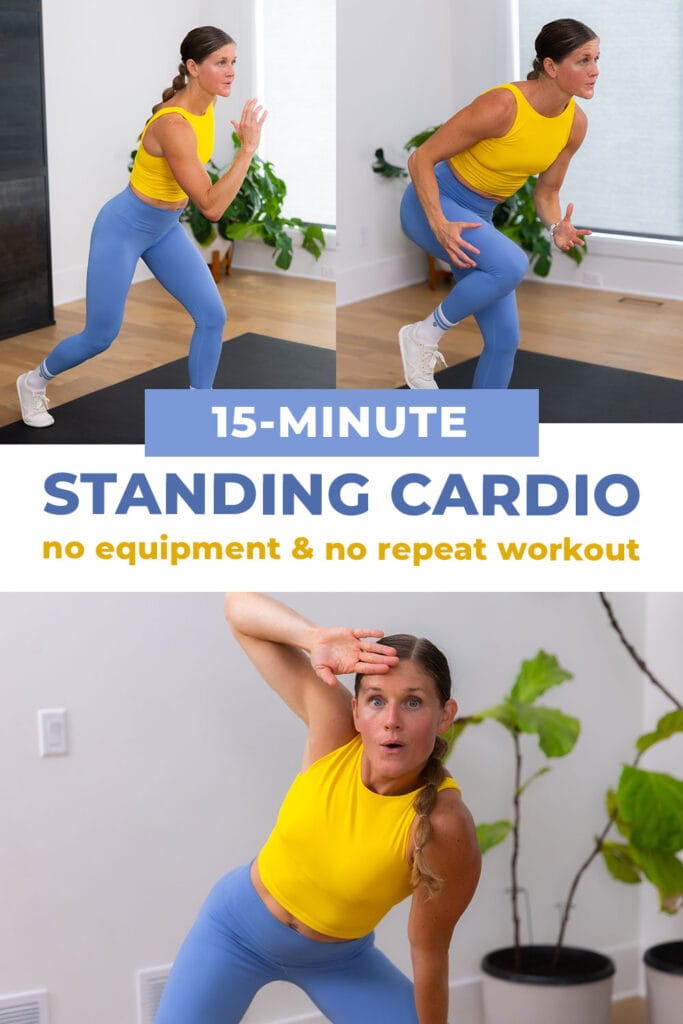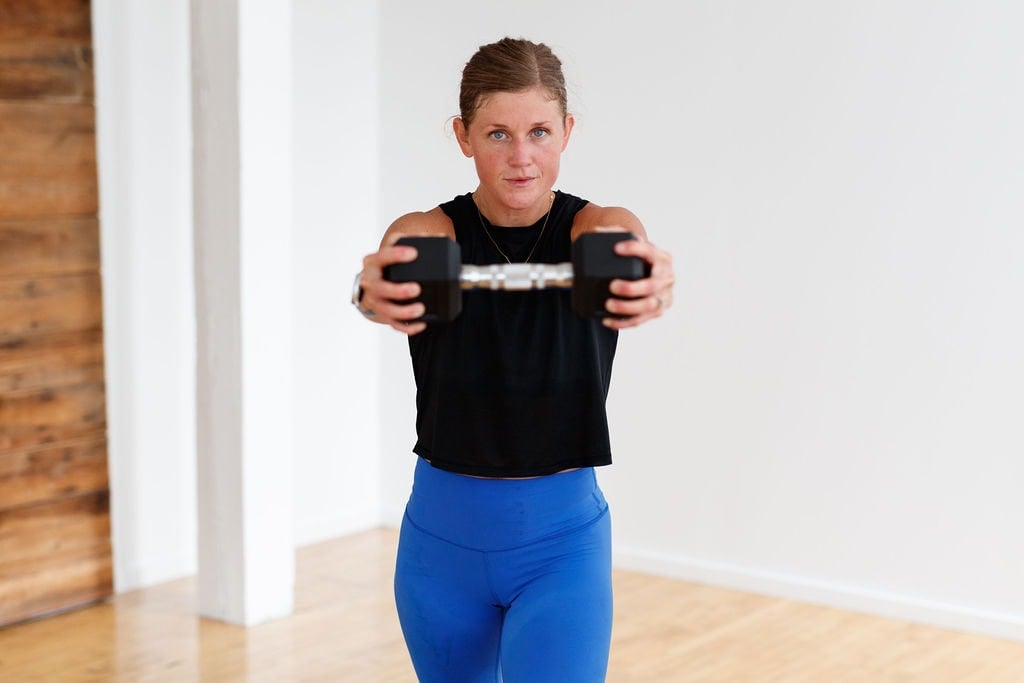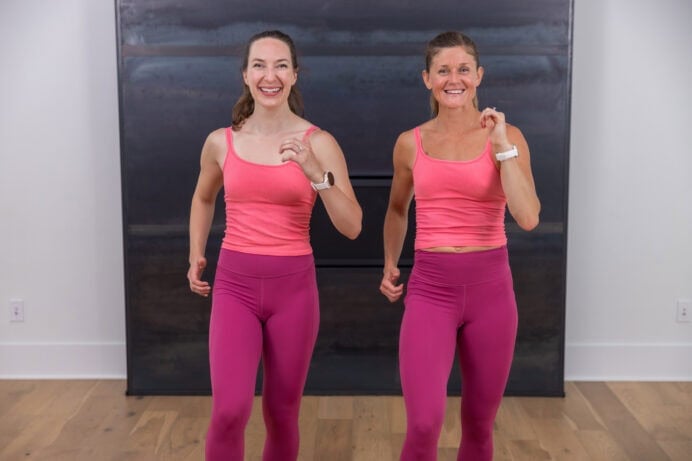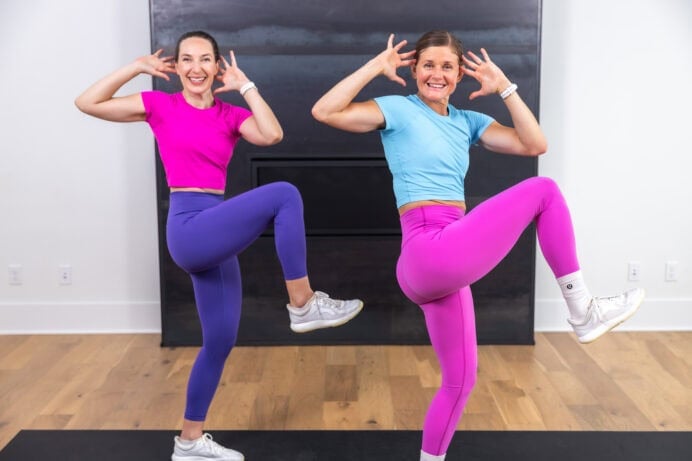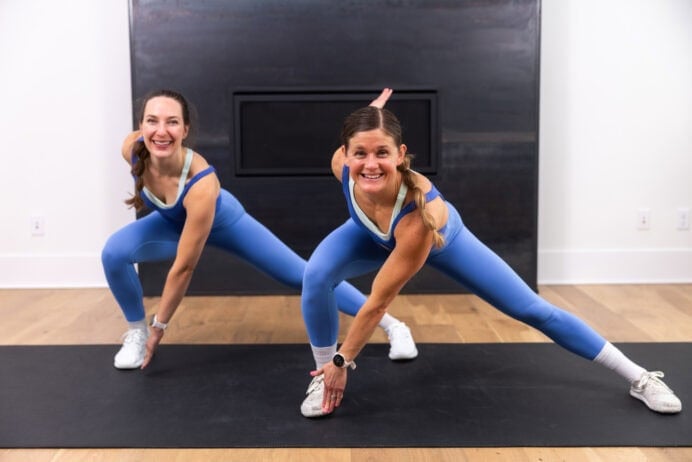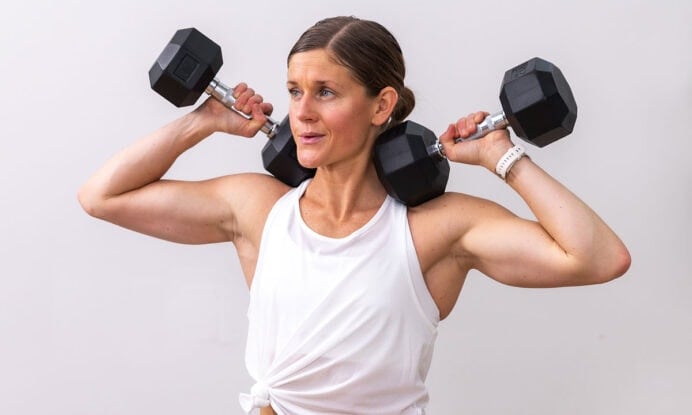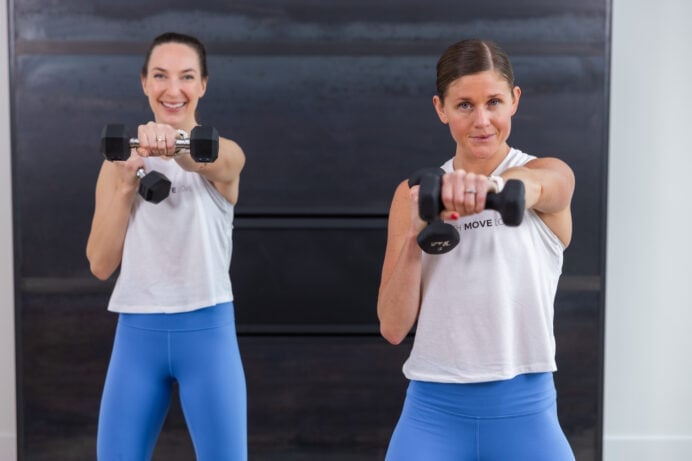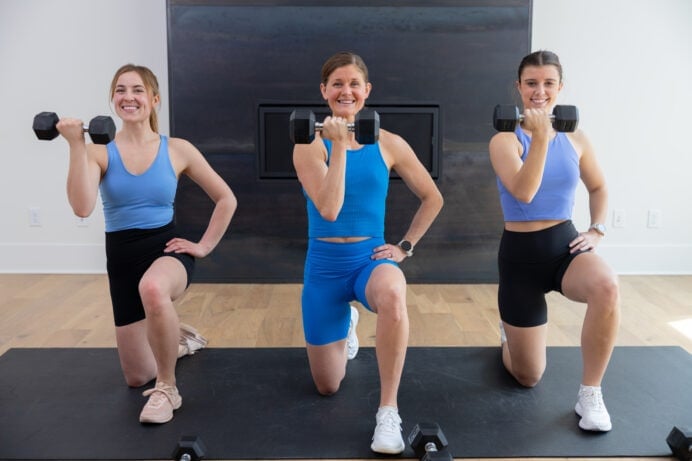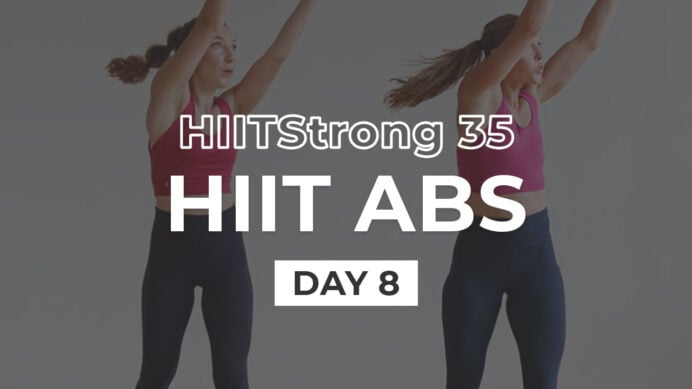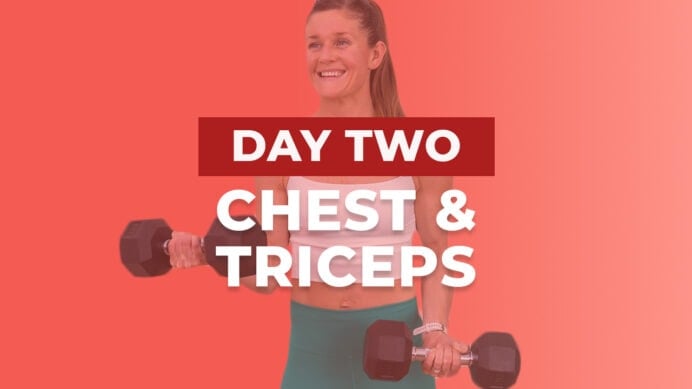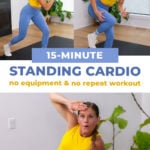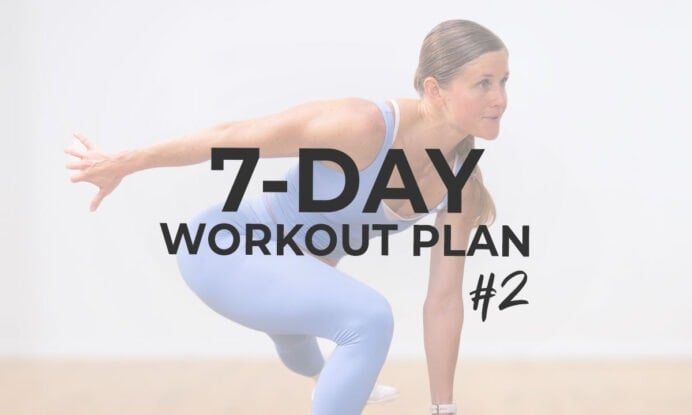
15 Bodyweight Cardio Exercises
This 15-minute, no-equipment, no-repeat bodyweight cardio workout is designed to boost endurance, burn fat and build strength – all in a short, efficient session. With built-in modifications, it’s accessible for beginners while still challenging for more advanced athletes. It’s ideal for busy people (like parents!) who want an effective, full-body sweat without needing a gym.
If there’s one thing I’ve learned as a trainer and a busy mom of 3, it’s that workouts need to be simple, efficient and effective – or they just won’t happen. That’s why I’m such a big fan of quick, no-equipment, bodyweight workouts.
The best bodyweight exercises are the ones you can do consistently and at an intensity that challenges you. Moves like squats, push-ups, burpees, lunges, jumping jacks and mountain climbers are classics for a reason. They work multiple muscle groups at once, get your heart rate up and can be scaled up or down depending on your fitness level.
When it comes to burning fat specifically, the best bodyweight cardio moves are the ones that spike your heart rate quickly while still being doable with good form. Think squat jumps, skaters, high knees or burpees. The key is intensity. You want to be working hard enough during each burst of effort that you’d rate it around an 8 or 9 out of 10 in terms of exertion. That’s what makes these kinds of workouts so powerful for fat loss: you’re not just burning calories during the workout itself, but also boosting your metabolism afterward.
So what does this actually look like in practice? One of my go-to bodyweight cardio routines is a no-equipment, no-repeat workout that takes just 15 minutes. It’s all bodyweight, and I’ve built in modifications so you can dial it up or down depending on your fitness level. For example, if we’re doing high knee skips, you can switch to marches if you need a low-impact option. Every exercise is different – you won’t repeat a single move – so you stay mentally engaged while your body works hard.
This type of high-intensity interval training (HIIT) is one of the most efficient ways to work out. You alternate short bursts of high-intensity effort with brief rest periods, keeping your heart rate elevated and maximizing fat burn in a fraction of the time of steady-state cardio. As much as I love these workouts, I don’t recommend doing them every single day. They’re intense, and your body needs time to recover. Instead, I mix them into a well-rounded weekly routine alongside strength training and active recovery days.
At the end of the day, you don’t need fancy equipment or hours at the gym to achieve your fitness goals. 15 minutes, your own bodyweight and the willingness to push yourself are all it takes to feel stronger and more energized.
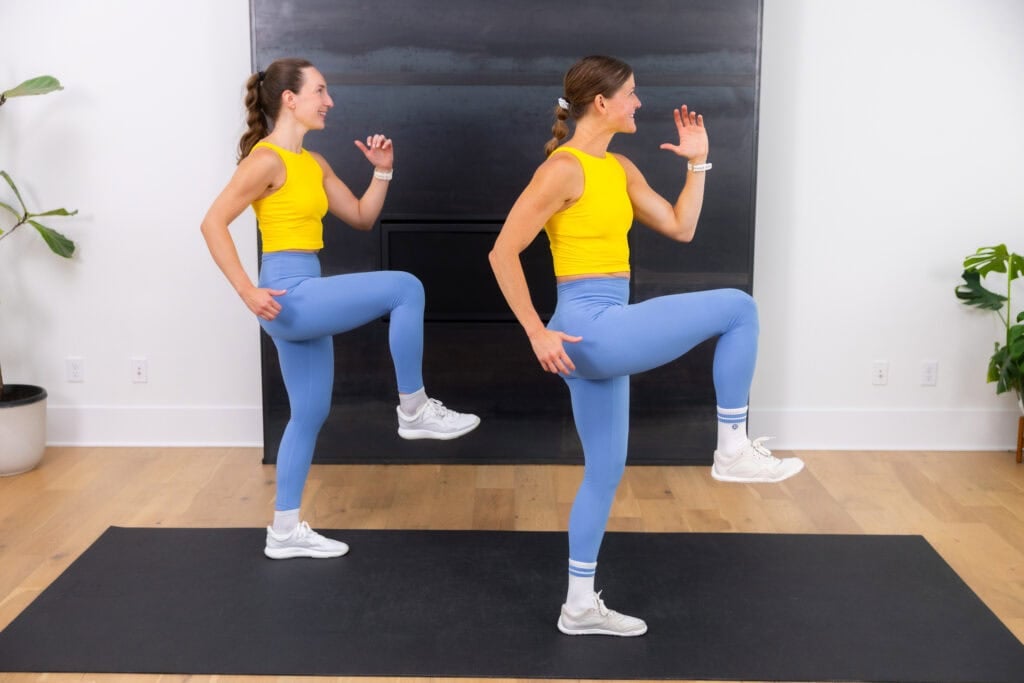
Read A 5-Star Review ⭐⭐⭐⭐⭐
“This is great! It will be great to have another cardio, no equipment option, with the colder weather looming. Also great for the travel season. Hope to see more!”
— Martha B.
Workout Details
This heart-pumping, full-body cardio workout is designed to encourage fat loss and build strength, using just your bodyweight.
I personally logged over 1,800 steps doing this bodyweight cardio workout; so it’s a great way to get your steps in at home too.
Modifications are offered to make this workout accessible to all fitness levels. I recommend adding HIIT cardio workouts like this to your home workout plan 1-2 times a week to improve endurance, boost athletic performance and burn fat.
Workout Equipment
No equipment. You just need your body weight for today’s cardio workout.
Workout Instructions
Follow along with the guided Cardio Workout on YouTube, led by me — your certified personal trainer, Lindsey Bomgren.
Your Workout Looks Like This:
- 15 Bodyweight Exercises (All Standing)
- Timed Intervals (perform each exercise for 40 seconds of work, followed by a 20-second rest period)
- No Repeat (performing each exercise x 1 set)
Workout Outline
1. High Knee Skips
Targets: Lower body – glutes, quads, hamstrings, calves, hip flexors and core.
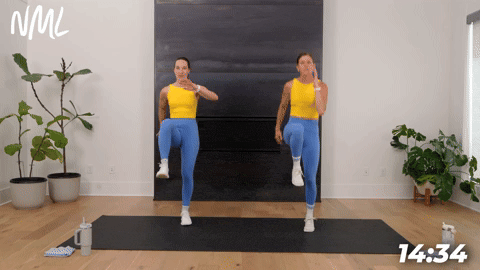
How to Do a High Knee Skip
- Start standing in an athletic position with your feet under your hips.
- Perform a high knee “skip.” Drive your right knee up, aiming to get your right thigh parallel to the ground, right knee is in line with your right hip (finding a 90-degree bend in the right knee).
- Return your right foot to the ground, landing softly on the balls of your feet. Repeat on the opposite side, driving your left knee up. Alternate the high knees quickly so you’re hopping throughout the entirety of the movement.
Modification: Make this exercise low-impact by omitting the hop and performing alternating high-knee marches.
2. Lateral Bounds
Targets: Quads, outer glutes (gluteus medius), inner thighs, calves and core.
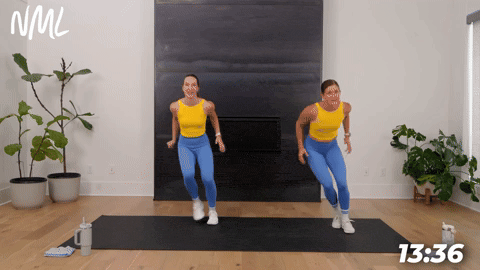
How to Do a Lateral Bound
- Start standing on the right side of your mat with your feet shoulder-width apart.
- Lower down into an athletic stance, knees bent, ready to move.
- Then drive off your right leg to bound laterally to the left.
- Reverse the movement, bounding laterally to the right.
3. On/Off Mat Runs
Targets: Quads, hamstrings, glutes, calves, hip flexors, core and low back.

How to Do an On/Off Mat Run
- Start standing at the edge of your workout mat in an athletic position with your feet under your hips.
- Step your right foot onto the mat, followed by your left foot, as if running forward.
- Quickly step your right foot back down to the ground behind the mat, then your left foot, returning to your starting position.
- Continue running your feet on and off the mat as quickly as possible, keeping a light bounce and pumping your arms to drive speed.
4. Jumping Jacks
Targets: Calves, quadriceps, glutes, hamstrings, hip abductors, shoulders and core stabilizers (abs and lower back).
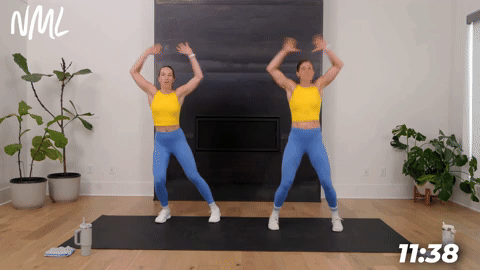
How to Do a Jumping Jack
- Start standing tall with your feet together and arms resting at your sides.
- Jump your feet out wider than hip-width as you swing your arms up and overhead, fingertips almost touching.
- Quickly jump your feet back together while lowering your arms to your sides, returning to the starting position.
- Repeat continuously at a steady pace, staying light on your feet and maintaining an upright posture.
Modification: Make this a low-impact exercise by omitting the jumping. Perform alternating tap outs, tapping the right foot out to the side, bringing it back in, then tapping the left foot out to the side.
5. Squat Jacks and Pogo Hops
Targets: Quadriceps, glutes, calves, hamstrings, hip abductors and core stabilizers.

How to Do a Squat Jack and Pogo Hop
- Start standing tall with your feet together and arms resting at your sides.
- Jump your feet out wider than hip-width as you bend your knees and lower into a squat, bringing your arms in front of you for balance.
- Jump up, bringing your feet back together to return to standing, then immediately perform 2 quick pogo hops in place (feet together, bouncing straight up and down using your calves).
- Repeat the sequence: wide-foot squat jack, feet together, then pogo hop. Maintain a steady rhythm, staying light on your feet.
Modification: Perform alternating side step squats and calf raises.
6. Lateral High Knees
Targets: Hip flexors, quadriceps, calves, glutes, hamstrings and core stabilizers (abs and obliques).
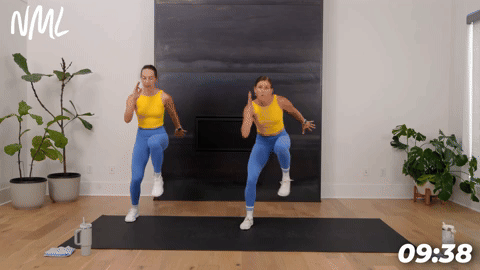
How to Do a Lateral High Knee
- Start standing tall with your feet under your hips and arms bent at 90 degrees by your sides.
- Begin driving your knees up toward hip height one at a time, performing high knees in place.
- As you pump your arms and lift your knees, start moving laterally to the right. Stay light on your feet and keep your knees high with each step.
- After several steps, switch directions and perform lateral high knees to the left. Continue alternating side to side for the duration of the set.
7. Ski Runs
Targets: Quadriceps, hamstrings, glutes, calves, hip flexors, abs, obliques, lower back, shoulders and arms.
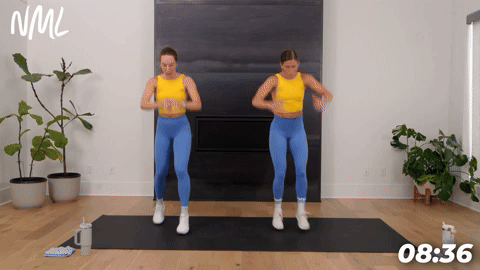
How to Do a Ski Run
- Start standing with your feet about shoulder-width apart, positioned as if on train tracks or skis. Place your right foot slightly in front of your left, keeping your weight balanced and arms bent at your sides.
- Jump your right foot forward, then your left foot forward, then your right foot forward again, maintaining the “ski track” stance.
- From here, drive your back left knee up toward your chest in a powerful knee drive.
- Reverse the sequence: jump your left foot forward, then your right, then your left, finishing with a right knee drive.
- Continue alternating sides, keeping your chest tall, your core braced, and your movements quick and athletic.
8. Jumping Jacks and High Skips
Targets: Quads, calves, glutes, hip flexors, hamstrings, shoulders, abs and lower back.
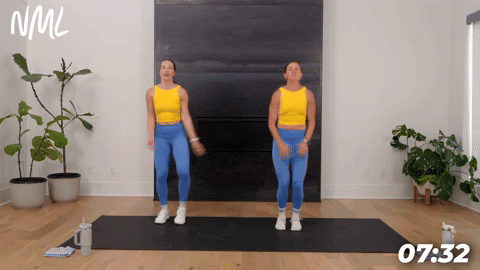
How to Do a Jumping Jack and High Skip
- Start standing tall with your feet together and arms resting at your sides.
- Perform 4 jumping jacks: jump your feet out wide while swinging your arms overhead, then jump back to feet together with arms at your sides.
- Immediately transition into 4 high knee skips: drive your right knee up toward hip height, then your left, alternating quickly and pumping your arms as you “skip” forward in place.
- Repeat the sequence of 4 jumping jacks followed by 4 high knee skips, maintaining a steady rhythm and staying light on your feet.
Modification: Perform alternating tap outs and high knee marches.
9. Skaters
Targets: Legs, glutes (outer gluteus medius), hips, calves, quads and core (for stability and balance).
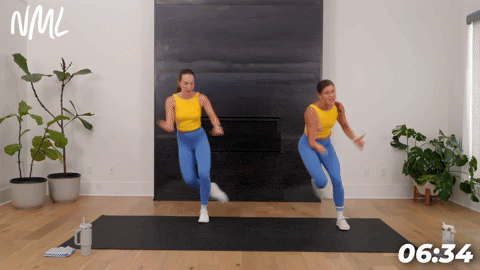
How to Do a Skater
- Start standing in an athletic stance, feet hip-width apart, knees slightly bent, core engaged.
- Push off your right foot to bound laterally to the left, landing in a loaded skater position on your left foot. Left knee bent, right leg tracking behind your left foot in a skater position.
- Then, drive off your planted left foot to bound laterally back to the right. Landing softly on your right foot. Right knee bent, left leg tracking behind your right foot in a skater position.
- Repeat, alternating the skaters on each leg.
10. Jabs and Jacks
Targets: Shoulders, arms (biceps and triceps), calves, quadriceps, glutes, hip flexors and core.
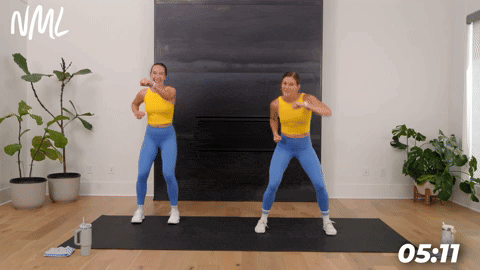
How to Do a Jab and Jack
- Start standing tall with your feet hip-width apart and hands in a guard position near your chest, elbows tucked in.
- Perform 4 quick jabs: extend your right fist forward, then your left, alternating rapidly while keeping your hands protected and your core engaged.
- Immediately follow with 2 jacks: jump your feet out slightly wider than hip-width, then back together, keeping your hands in the guard position rather than overhead.
- Repeat the sequence, maintaining a steady rhythm, staying light on your feet, and keeping your core engaged throughout.
Modification: Perform alternating step outs or taps rather than jacks.
11. Lateral Shuffle
Targets: Legs, glutes (outer gluteus medius), hips, calves, quads and core (for stability and balance).
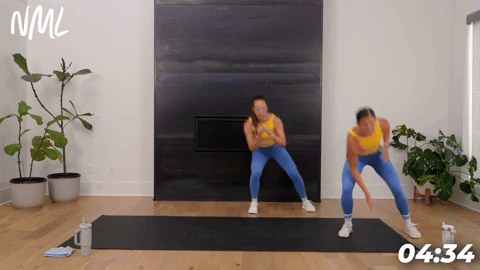
How to Do a Lateral Shuffle
- Start standing in an athletic stance, feet hip-width apart, knees slightly bent, core engaged.
- Leading with the right foot and following with the left foot, take two large shuffles towards the right. Option to tap the ground.
- Then reverse the movement, leading with your left foot as you take two large shuffles towards the left, returning to the starting position.
12. Butt Kicks and Jump Rope
Targets: Hamstrings, glutes, calves, quadriceps, hip flexors, shoulders and core.
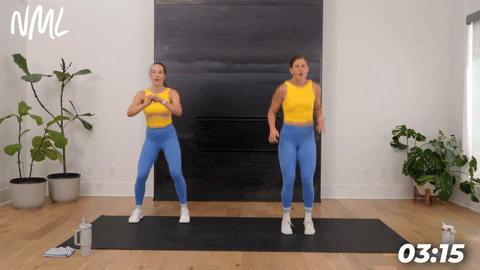
How to Do a Butt Kick and Jump Rope
- Start standing tall with your feet under your hips and arms relaxed at your sides.
- Perform 4 alternating butt kicks: quickly bring your right heel up toward your glute, then your left, alternating back and forth for 4 total kicks. Keep your chest tall and your core engaged.
- Immediately transition into 4 jump ropes: hop straight up and down with both feet together, mimicking the motion of turning a rope with your wrists.
- Repeat the sequence of 4 butt kicks followed by 4 jump ropes, maintaining a quick, steady rhythm and staying light on your feet.
Modification: Slow it down, performing 2 butt kicks and 2 jump ropes. Omit the impact by taking out the jump in this movement.
13. Knee Slams
Targets: Hip flexors, quadriceps, glutes, core (abs and obliques), shoulders, lats and calves.
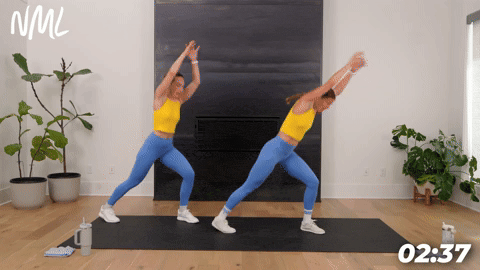
How to Do a Knee Slam
- Start standing in an athletic stance, body angled slightly to the right, with your weight balanced.
- Bring your arms overhead, then drive your left knee up toward your chest while pulling your arms down forcefully, as if “slamming” the knee into your hands.
- Perform 3 knee slams on the left side with power and control.
- After the third, hop to turn your body so you’re angled to the left.
- Immediately perform 3 knee slams on the right knee, driving the knee up as your arms pull down.
- Continue alternating sides in this pattern, staying light on your feet and explosive through each slam.
14. Speedbag
Targets: Arms, shoulders, biceps, abs, core and calves.
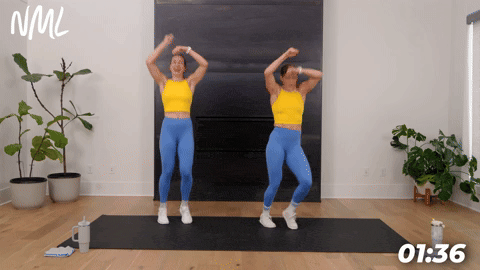
How to Do a Speedbag
- Start standing, feet hip-width apart, knees bent, core engaged.
- Raise your arms above your head, bending the elbows and forming fists with your hands.
- Make small circular motions with your fists as you “hit” your imaginary boxing bag.
15. High Knee Sprints
Targets: Legs, glutes, quads, hamstrings, calves, hip flexors and core.

How to Do a High Knee Sprint
- Start standing in an athletic position with your feet under your hips.
- Perform high knees. Drive your right knee up, aiming to get your right thigh parallel to the ground, right knee is in line with your right hip (finding a 90-degree bend in the right knee).
- Return your right foot to the ground and repeat on the opposite side, driving your left knee up. Alternate the high knees quickly so you’re hopping throughout the entirety of the movement.
- As you get going, pick up the pace so you’re performing the high knees quickly (“sprinting”).
- Slow the pace back down, then pick it back up again, alternating speed throughout the timed interval.
Modification: Make this low impact by omitting the hop, performing alternating high knee marches. You can pick up the pace a bit during the “sprints” while still keeping this low impact.
FAQs
Yes, bodyweight training can be effective for resistance training. Exercises like bodyweight squats, push-ups, planks and lunges use your own body as resistance, challenging multiple muscle groups at once. By adjusting tempo, reps or range of motion, you can continue to build strength over time without needing equipment.
You can build muscle with bodyweight exercises, especially when you focus on progressive overload (making the moves harder over time). For example, you might start with push-ups from your knees, then progress to full push-ups from your toes and eventually to decline or plyometric push-ups. While heavy weights can speed up muscle growth, consistent bodyweight training is more than enough to increase muscle tone, strength and endurance (especially if you’re new to fitness or working out at home).
More Workouts
Cardio WorkoutsPin This Bodyweight Cardio Workout (15 Exercises)
